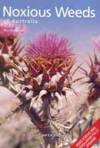Weeds pose a serious threat to human and animal health, to primary production and to our natural environment. Weeds reduce farm productivity, displace native species and contribute to on-going land degradation and reduced land values. (Photo shows cattle dead after feeding on the noxious weed, green cestrum (Cestrum parqui). 
Green Cestrum
Like many of our noxious weeds, the toxic green cestrum (Cestrum parqui) was introduced into Australia as a garden plant. Easy to grow, its attractive, yellow flowers guaranteed widespread plantings in gardens everywhere. Birds and river systems have done the rest, spreading the plant’s black berries into rural areas in many parts of New South Wales.
Birds spread green cestrum seeds from garden situations to neighbouring lands. Usually, the birds head for the cool shade of trees along waterways. The new plants flourish in these well-watered areas, and the cycle continues at an ever-increasing rate.
How to Identify Green Cestrum
Green cestrum flowers are yellow and trumpet-shaped. The dark green leaves are smooth and shiny. The photograph below shows the leaf, berries and flowers. 
Cestrum grows to a height of around 3 metres. Apart from the distinctive, yellow, trumpet-shaped flowers, there are a number of other important identification procedures, these include:
- The stems/branches are very brittle. They snap off easily.
- Crush a leaf between your fingers. The smell is very unpleasant! Don't rub your eyes! Wash your hands afterwards!
- Green cestrum sheds some of its leaves through the winter, and new growth kicks in during spring.
- Green cestrum officially flowers late spring to late summer.
Effect on Animals?
Green cestrum can be toxic to animals including sheep, horses, pigs, poultry but especially cattle! According to "Noxious Plants of Australia" by Parsons & Cuthbertson it does not take much plant material to affect animals, "animals become feverish with poor appetites and increased thirst, are excited and sometimes scour before developing a general paralysis. Death usually occurs within hours of the first signs of symptoms so animals are often found dead without any symptoms being seen. Post-mortem examination shows general haemorrhaging throughout the body tissues, a large amount of blood in the bowel and severe gastroenteritis".
Stock Owners Should Never Take the Plant for Granted
Green cestrum is a mysterious plant. Animals can graze in amongst it for months without any problems. Then, "out of the blue", a change of weather conditions (especially light rain after an extended dry spell) or some other climatic phenomena triggers a change in the chemistry of the plant which in turn makes the plant attractive to stock – especially hungry stock.
The main danger period for animals is when the plants have been broken off, chemically treated or drought affected. As the plant material dries out, it can become more attractive to animals. Any part of the plant can be toxic.
Another danger period is when stock, particularly cattle, are put into a new paddock. In these situations, stressed and disorientated animals will often try a variety of plants that they would not normally eat.
Control Method
1. Manual control is an option for small patches. Physical removal of all plant material is very difficult because of the complex root system but the plant will eventually give up if you keep at it. Never leave any plant material where it can be eaten by stock. Drying plant material is at its most dangerous.
2. Manual control is an option for small patches. Physical removal of all plant material is very difficult because of the complex root system but the plant will eventually give up if you keep at it. Never leave any plant material where it can be eaten by stock. Drying plant material is at its most dangerous.
3. They are a number of herbicides registered for treatment of green cestrum. Again, a word of warning. Animals may be tempted to eat the plant material as it is drying out. Keep stock away until well after the leaves and other soft parts of the plant have decomposed.
In Summary
Many small land holders do care about weeds, and include weed control programs in their property management plans. Unfortunately, there are others who do not have the resources or the will to maintain their properties as they should.
Land managers aren't necessarily expected to keep their properties completely free of noxious weeds (unless it's a CC1 or CC2 weed of course!). They are, however, expected to take reasonable measures to keep weeds under control. Those who do nothing are letting themselves and their neighbours down! They are also liable to prosecution under the Noxious Weeds Act 1993.
Where to From Here?
For further information regarding weed detection and control on small farms, (click here). Alternatively purchase a copy of Noxious Weeds of Australia.

Acknowledgement
This information has been adapted from North West Weeds.



